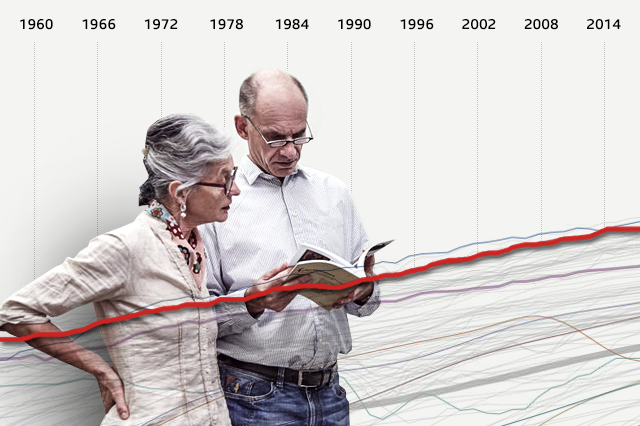Swiss pension system marks a milestone – and a turning point

One of the most important referendums in Swiss direct democracy is celebrating its 70th anniversary. On July 6, 1947, citizens voted unequivocally in favour of the Old Age and Survivors Insurance (OASI) law. But once the country’s pride and joy, it’s now a problem child.
The act came into force half a year after the impressive popular decision: the postman knocked on doors, got out his large wallet and put between CHF40 and CHF125 in the hands of greying men and women, creating a new type of person: the OASI pensioner*.
From January 1, 1948, those who had reached 65 and had thus worked for long enough received a portion of their former salary – now in the form of insurance contributions. To this day, the social insurance has been financed by contributions from employers and employees deducted in proportion to the salary either paid or received.
The OASI was created at a time that was anything but a defining moment of democracy, but rather one in which the cabinet led an authoritarian regime. During the Second World War, it governed the country with sovereign power and could pass or abolish laws as it pleased to some extent, in accordance with emergency legislation. Parliament was largely excluded; the people even more so.
But this didn’t stop the OASI from becoming a milestone in Swiss politics.
Under threat
However, its prospects have been bleak for some years: without fundamental reform, old-age insurance is threatened by demographic changes. While the number of pensioners is increasing, the number of contributing workers is decreasing.
The first step towards securing the OASI in the medium term will be taken in September, when the Swiss return to the ballot box to vote on the “2020 Pension Scheme Reform”. The main aim of this is to increase the retirement age of women from 64 to 65.
*Some Swiss cantons had obligatory pensions before 1947: Glarus (since 1916), Appenzell Ausser Rhoden (1925) and Basel City (1932). Pensions were optional in Neuchâtel (1898) and Vaud (1907).
Translated from German

In compliance with the JTI standards
More: SWI swissinfo.ch certified by the Journalism Trust Initiative













You can find an overview of ongoing debates with our journalists here . Please join us!
If you want to start a conversation about a topic raised in this article or want to report factual errors, email us at english@swissinfo.ch.